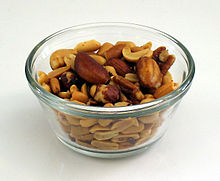**True Nuts:**
– Acorn (Quercus, Lithocarpus, and Cyclobalanopsis spp.)
– Beech (Fagus spp.)
– Breadnut (Brosimum alicastrum)
– Candlenut (Aleurites moluccana)
– Chestnuts (Castanea spp.)
**Drupes Seeds:**
– Almonds (Prunus dulcis)
– Apricot kernels
– Australian cashew nut (Semecarpus australiensis)
– Betel or areca nuts (Areca catechu)
– Baru nut (Dipteryx alata)
**Gymnosperm Seeds:**
– Pine nuts
– Johnstone River almond (Elaeocarpus bancroftii)
– Mongongo (Ricinodendron rautanenii)
– Sacha inchi (Plukenetia volubilis)
– Palm nuts (Elaeis guineensis)
**Angiosperm Seeds:**
– Peanuts
– Kola nut (Cola spp.)
– Kurrajong (Brachychiton spp.)
– Malabar chestnut (Pachira aquatica)
– Red bopple nut (Hicksbeachia pinnatifolia)
**Other Culinary Nuts:**
– Hazelnuts (Corylus spp.)
– Guinea peanut (Pachira glabra)
– Deeknut (Corylus dikana)
– Karuka (Pandanus spp.)
– Yellow walnut (Beilschmiedia bancroftii)
**Nut-like Seeds:**
– Pine nuts, Cycads (Macrozamia spp.), Burrawang nut (Macrozamia communis), Ginkgo nuts (Ginkgo biloba)
– Macadamia nuts, Brazil nut (Bertholletia excelsa), Paradise nut (Lecythis usitata)
– Cashew, Coconut (Cocos nucifera), Gabon nut (Coula edulis), Hickory (Carya spp.)
– Irvingia spp., Bush mango (Irvingia gabonensis), Ogbono nut (Irvingia wombolu), Jack nuts (Artocarpus heterophyllus), Jelly Palm Nut (Butia capitata)
– Walnut (Juglans spp.), Black walnut (Juglans nigra), Butternut (Juglans cinerea), English walnut (Juglans regia), Heartnut (Juglans aitlanthifolia)
**Nutritional Benefits:**
– Rich in antioxidants
– Good source of healthy fats
– May lower cholesterol levels
– Support heart health
– Provide essential nutrients
**Culinary Uses:**
– Snacking
– Baking
– Cooking
– Making nut butter
– Adding to salads
**Harvesting and Processing:**
– Harvested at different times
– Processing involves shelling and sorting
– Some nuts need roasting before consumption
– Nuts can be stored for long periods
– Different methods for extracting nut oils
**Global Production:**
– Largest producers include the US and China
– Production affected by weather conditions
– Growing demand for nuts worldwide
– Economic impact on producing countries
– Various uses in different cuisines
A culinary nut is a dry, edible fruit or seed that usually, but not always, has a high fat content. Nuts are used in a wide variety of edible roles, including in baking, as snacks (either roasted or raw), and as flavoring. In addition to botanical nuts, fruits and seeds that have a similar appearance and culinary role are considered to be culinary nuts. Culinary nuts are divided into fruits or seeds in one of four categories:
- True, or botanical nuts: dry, hard-shelled, uncompartmented fruit that do not split on maturity to release seeds; (e.g. hazelnuts)
- Drupes: seed contained within a pit (stone or pyrena) that itself is surrounded by a fleshy fruit (e.g. almonds, walnuts);
- Gymnosperm seeds: naked seeds, with no enclosure (e.g. pine nuts);
- Angiosperm: seeds surrounded by an enclosure, such as a pod or a fruit (e.g. peanuts).


Nuts have a rich history as food. For many indigenous peoples of the Americas, a wide variety of nuts, including acorns, American beech, and others, served as a major source of starch and fat over thousands of years. Similarly, a wide variety of nuts have served as food for Indigenous Australians for many centuries. Other culinary nuts, though known from ancient times, have seen dramatic increases in use in modern times. The most striking such example is the peanut. Its usage was popularized by the work of George Washington Carver, who discovered and popularized many applications of the peanut after employing peanut plants for soil amelioration in fields used to grow cotton.
